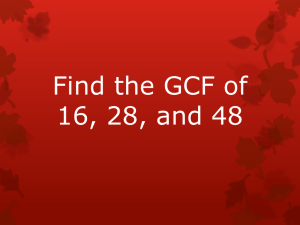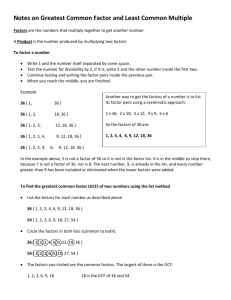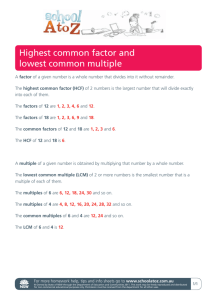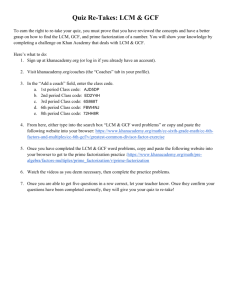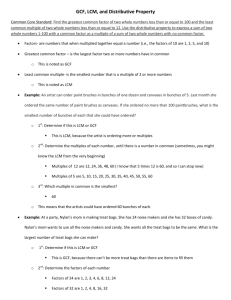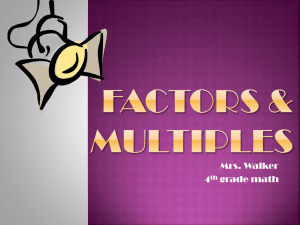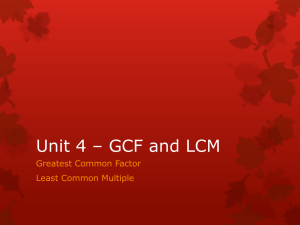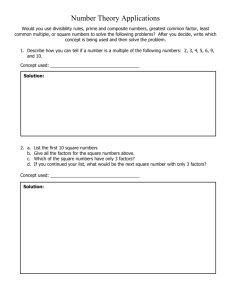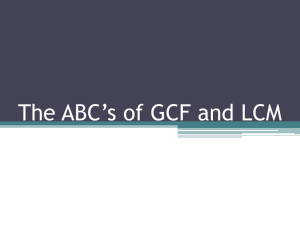Greatest Common Factor and Least Common Multiple Lesson
advertisement
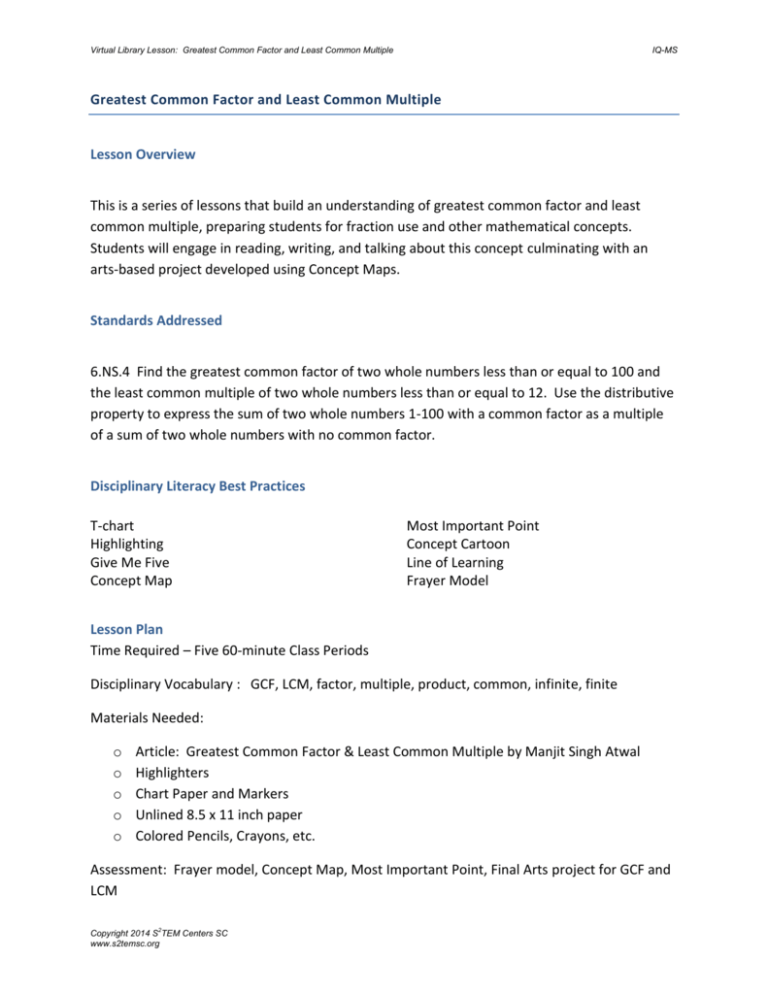
Virtual Library Lesson: Greatest Common Factor and Least Common Multiple IQ-MS Greatest Common Factor and Least Common Multiple Lesson Overview This is a series of lessons that build an understanding of greatest common factor and least common multiple, preparing students for fraction use and other mathematical concepts. Students will engage in reading, writing, and talking about this concept culminating with an arts-based project developed using Concept Maps. Standards Addressed 6.NS.4 Find the greatest common factor of two whole numbers less than or equal to 100 and the least common multiple of two whole numbers less than or equal to 12. Use the distributive property to express the sum of two whole numbers 1-100 with a common factor as a multiple of a sum of two whole numbers with no common factor. Disciplinary Literacy Best Practices T-chart Highlighting Give Me Five Concept Map Most Important Point Concept Cartoon Line of Learning Frayer Model Lesson Plan Time Required – Five 60-minute Class Periods Disciplinary Vocabulary : GCF, LCM, factor, multiple, product, common, infinite, finite Materials Needed: o o o o o Article: Greatest Common Factor & Least Common Multiple by Manjit Singh Atwal Highlighters Chart Paper and Markers Unlined 8.5 x 11 inch paper Colored Pencils, Crayons, etc. Assessment: Frayer model, Concept Map, Most Important Point, Final Arts project for GCF and LCM Copyright 2014 S2TEM Centers SC www.s2temsc.org Virtual Library Lesson: Greatest Common Factor and Least Common Multiple IQ-MS Engage (Day One) o Students will enter classroom with instructions on the board to respond to the following questions: What are multiples? What are factors? Create a T-Chart to organize your thoughts. o Provide students 5 minutes to write down their thoughts. Allow them 3 minutes to move around the room using a strategy called “Give One to Get One”. To do this, students must find someone to talk with, share one of their responses in the list from their T-Chart and get one from another. Once they have given one and received one response, they then move to another student and repeat the same process. Tell them their goal is to “give and get” as many responses as possible within the 3 minutes. They should write down any ideas they “get” that are not already on their T-Chart for either multiples or factors. o HINT: Using this strategy and timing them helps them keep focused on keeping their dialogue productive and listening to each other. o **For higher level thinking, instead of using “Give One to Get One”, use “Around the Room and Back Again”. In this strategy, students are given a set amount of time; they move about the room with no paper or pencil and speak to as many students as they can. When time is called, students return to their seats and add any new information to their T-Chart. This strategy is great to use to keep students focused on listening to each other and recalling information. o Students will work in a small group to complete a T-Chart for Factors and Multiples on chart paper, combining everything they have heard throughout the activity. Groups will share and post their T-Charts on the wall for future reference. Explore (Day Two) o As students enter the room, show a concept cartoon for GCF and/or LCM. This can be teacher-created or one that is found on the internet. Show this cartoon on the board. In their notebooks, have students write about whether they agree with what is being said in the cartoon or disagree and explain their reasoning. After about 5 minutes, use “Give Me Five” to share out what they are thinking. (Give Me Five – 5 students will share their response to the concept cartoon.) o Students will receive a copy of the article: Greatest Common Factor & Least Common Multiple by Manjit Singh Atwal and highlighters. Instruct students to highlight definitions, characteristics, and examples of GCF and LCM, as well as, any other key information about the two terms. Highlighting such important information gives them a purpose for their reading. Explain to students the purpose of highlighting is to highlight only the needed information and not the entire article. Copyright 2014 S2TEM Centers SC www.s2temsc.org Virtual Library Lesson: Greatest Common Factor and Least Common Multiple IQ-MS o After reading the article and highlighting important information, they will use this and their T-Charts to create two Frayer Models: one for GCF and one for LCM. After completing Frayer Models, students will create problems (with parameters) to find GCF and LCM for other students to complete. o Before students leave – have them respond to the following question in their notebooks or collect on a sheet of paper as a formative assessment: What is the most important point to remember for GCF? What is the most important point to remember for LCM? Explain (Day Three) o To begin this part of the lesson, have students respond in notebooks to the following question: What connections are you making between greatest common factor and least common multiple? o (Whole class dialogue about connections students are making.) o Present students with the following words to complete a concept map: GCF, LCM, factors, multiples, and common. Explain to students to make as many connections as possible. To show connections, they will draw a line to connect the word, number the line, and write a sentence that describes the connection. Students should draw from their knowledge and information they have learned from the past couple of days from reading the article, classroom dialogue, and completing their T-Charts and Frayer Models. Once these words have been used and students have made as many connections they could make, add in 3 more symbols and words: product, ≥, ≤. Students may need to have dialogue about the symbols prior to using. While this may be a little more challenging, it will serve as an assessment of where students are with this concept and what type of connections they can make with additional information. Allow students time to work on their concept map. o *Near the end of class, return to the original question. Have students draw a LINE OF LEARNING underneath their original response and write what they are thinking now. Extend (Days 4 and 5) o Students will use their T-Charts, Frayer Models, writing responses, and Concept Maps to bring in the arts and create a song, rap, poem, play, piece of artwork, etc. that illustrates their understanding to GCF and LCM. They will be able to choose what group to work in according to what they want to produce. On the last day, each group will perform their song, poem, play, show their artwork and explain it, etc. Lesson Assessment: Frayer Model, Concept Map, Writing for Line of Learning, Most Important Points Final Arts Project for GCF and LCM Copyright 2014 S2TEM Centers SC www.s2temsc.org Virtual Library Lesson: Greatest Common Factor and Least Common Multiple IQ-MS Teacher Biographical Information Lesson Author: Christy Junkins is a 6th grade math teacher at Middle School of Pacolet in Spartanburg, SC. She has 10 years of teaching experience in education that includes grades 5 (all content areas) and grades 6-8 (math, science, and social studies). Copyright 2014 S2TEM Centers SC www.s2temsc.org Virtual Library Lesson: Greatest Common Factor and Least Common Multiple IQ-MS Greatest Common Factor (gcf) And Least Common Multiple (lcm) By Manjit Singh Atwal LCM and GCF There are many reasons which make math a hard and most hated subject among the average students. One of the most important reasons is the insufficient knowledge of basic math concepts such as least common multiple (lcm) and greatest common factor (gcf). Many students don't care about these basic concepts when there is a right time to learn these basic math skills. After reading this article students who lack the knowledge of least common multiple and greatest common factor, can better understand these skills and they can apply this knowledge in higher math concepts, such as solving fractions or algebraic expressions. Least Common Multiple (LCM): If students know the times tables, then they can find multiples of a number quite easily as multiples are the "times" of the given number. To find least common multiple of two numbers students have to find multiples of both numbers and pick a common multiple which is the smallest of all. That smallest common multiple of both numbers is called the least common multiple. For example; consider we want to find "lcm" of numbers "6" and "8". To find "lcm" of these number write the first 5 multiples of both the numbers as shown below: 6 = 6, 12, 18, 24, 30 8 = 8, 16, 24, 32, 40 Now by looking at first five multiples of both the numbers, we can locate the lcm for both, which is "24". There is no other multiple smaller than 24, which is common for both the given numbers. Hence, "24" is the "lcm" of "6" and "8". Sometimes there is no common multiple in first five multiples of both the numbers, in this case write the next five multiples to locate the least common multiple. Greatest Common Factor (gcf): Similar to the "lcm", greatest common factor is another key skill students need to understand from the core. To find the greatest common factor of two numbers students need to find all the factors of both the numbers and then the biggest common factor is called the greatest common factor or gcf. For example; consider we want to find the gcf of numbers "12" and "32". To find the gcf of the given numbers write all the factors of given numbers as shown below: 12 = 1, 2, 3, 4, 6, 12 32 = 1, 2, 4, 8, 16, 32 By looking at all the factors of both the numbers, it is clear that number "4" is the greatest common factor for the given numbers "12" and "32". Article Source: http://EzineArticles.com/?expert=Manjit_Singh_Atwal Copyright 2014 S2TEM Centers SC www.s2temsc.org
